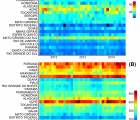The Zika virus has been the primary suspect in the large increase in incidence of microcephaly in 2015-6 in Brazil. While evidence for Zika being the cause of some of the cases is strong, its role as the primary cause of the large number of cases in Brazil has not been confirmed. Recently, the disparity between the incidences in different geographic locations has led to questions about the virus’s role. Here we consider the alternative possibility that the use of the insecticide pyriproxyfen for control of mosquito populations in Brazilian drinking water is the primary cause. Pyriproxifen is a juvenile hormone analog which has been shown to correspond in mammals to a number of fat soluble regulatory molecules including retinoic acid, a metabolite of vitamin A, with which it has cross-reactivity and whose application during development has been shown to cause microcephaly. Methoprene, another juvenile hormone analog that was approved as an insecticide based upon tests performed in the 1970s, has metabolites that bind to the mammalian retinoid X receptor, and has been shown to cause developmental disorders in mammals. Isotretinoin is another example of a retinoid causing microcephaly in human babies via maternal exposure and activation of the retinoid X receptor in developing fetuses. Moreover, tests of pyriproxyfen by the manufacturer, Sumitomo, widely quoted as giving no evidence for developmental toxicity, actually found some evidence for such an effect, including low brain mass and arhinencephaly—incomplete formation of the anterior cerebral hemispheres—in exposed rat pups. Finally, the pyriproxyfen use in Brazil is unprecedented—it has never before been applied to a water supply on such a scale. Claims that it is not being used in Recife, the epicenter of microcephaly cases, do not distinguish the metropolitan area of Recife, where it is widely used, and the municipality, and have not been adequately confirmed. Given this combination of information about molecular mechanisms and toxicological evidence, we strongly recommend that the use of pyriproxyfen in Brazil be suspended until the potential causal link to microcephaly is investigated further.
Introduction: Brazil is facing, since October of 2015, an outbreak of microcephalic fetuses. This outbreak is correlated with the beginning of circulation of Zika virus (ZIKV) in the country. Although it is clear that the size of the head is diminished in these fetuses, the brain phenotype associated with these malformations is unknown.
Methods: We collected computed tomography images of the microcephaly cases from the region of Natal, Rio Grande do Norte, from September 2015 to February 2016.
Findings: The microcephalies derived from the current outbreak are associated with intracerebral calcifications, malformation of the ventricular system, migratory disorders in the telencephalon and, in a lower frequency, malformation of the cerebellum and brainstem.
Discussion: The characteristics described herein are not usually found in other types of microcephaly. We suggest that this work can be used as a guideline to identify microcephaly cases associated to the current outbreak.

Because of the potential link between the ongoing Zika virus outbreak and a surge in the number of cases of congenital microcephaly, officials in Latin America have recommended that women postpone pregnancy until this association is firmly established or the outbreak subsides. However, in all these countries a large proportion of babies are still born out of unplanned pregnancies. Teenage girls are particularly at high risk, as they often lack access to preventive contraception methods, or the knowledge to use them appropriately. To gauge the magnitude of the barriers preventing the implementation of such a recommendation in Brazil, the country so far most affected by the Zika epidemic, we evaluated pregnancy rates in teenage girls, and their spatial heterogeneity in the country, in recent years (2012-2014). Nearly 20% of children born in Brazil today (~560,000 live births) are by teenage mothers. Birth incidence is far higher in the tropical and poorer northern states. However, in absolute terms most births occur in the populous southeastern states, matching to a large extent the geographic distribution of dengue (an indicator of suitable climatic and sociodemographic conditions for the circulation of Aedes mosquitoes). These findings indicate that recommendation to delay pregnancy will leave over half a million pregnant adolescents in Brazil vulnerable to infection every year if not accompanied by effective education and real access to prevention.
